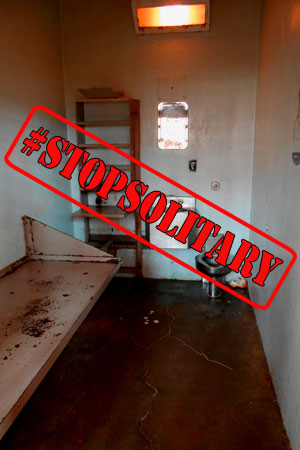Shining a Light on Solitary Confinement
Solitary Confinement in Ohio Read the Executive Summary Watch Stories from Solitary Download the Full Report
Update: Over 500 Ohioans wrote to Ohio’s prisons director, Gary Mohr, demanding expansive reforms to Ohio’s use of solitary confinement, and protections for people with mental illness who are particularly vulnerable to its destructive impact. Thanks to your advocacy, the Ohio Department of Rehabilitation and Correction (ODRC) has been removing individuals with serious mental illnesses from solitary confinement, and has continued to depopulate the most extreme levels of solitary confinement.
The ACLU of Ohio will continue working with Disability Rights Ohio to ensure that ODRC institutes further reforms and adopts formal policies that keep people with a mental illness of any kind out of solitary confinement.
Alone. Locked in a cage.
Only the dim fluorescent light and concrete walls to keep you company. Here you will sit all day, every day. Once or twice each day, you are moved from that cage to another cage and then right back to the first cage. It is hard to move, so your muscles atrophy. Soon you begin to feel like your brain has atrophied too. Time loses all meaning and your mind begins to play tricks on you. Will you ever be free?
This is solitary confinement in Ohio.
Solitary confinement is torture. It removes all social interaction from a person’s life and inflicts tremendous mental, emotional, and physical pain. Those who have spent time in solitary confinement often describe it as the worst of their prison experiences.
People with mental illnesses are especially vulnerable. Medical experts have condemned solitary confinement because of its terrible effects on a person’s psyche. People with mental illnesses are more likely to be held in solitary confinement, and if you did not have a mental illness already, you are likely to leave with one.
It puts public safety at risk. Every year in Ohio, dozens of prisoners are released directly from solitary to the community, oftentimes with no tools to make the transition.

Solitary confinement costs more, while making us less safe. It costs two and half times as much to house an Ohio prisoner in maximum security prison as it does a medium or minimum security prison. Other states that have implemented reforms to reduce solitary confinement have saved money and seen decreases in violence at their prisons.

Solitary confinement is damaging to prisoners, ineffective, costly, and makes us less safe—so why are we still using it?
Luckily, Ohio prison officials have begun to realize that solitary confinement is a practice that needs to end. Prison leaders have taken steps to reduce the number of people in the highest security levels, and have pledged other reforms including prohibiting people with serious mental illnesses from entering solitary confinement.
These may be positive reforms, but details and implementation are still being finalized. Even with these changes, Ohio needs to go much farther to end the use of solitary confinement altogether. The ACLU of Ohio and Disability Rights Ohio recommend that Ohio prisons:
- Promote alternatives to solitary confinement and shrink the overall number of people housed in it.
- Decrease people’s length of stay, and discourage the use of long-term solitary confinement.
- Increase programming and out-of-cell time to help support prisoners and aid their rehabilitation.
This is a joint report by the ACLU of Ohio and Disability Rights Ohio.

